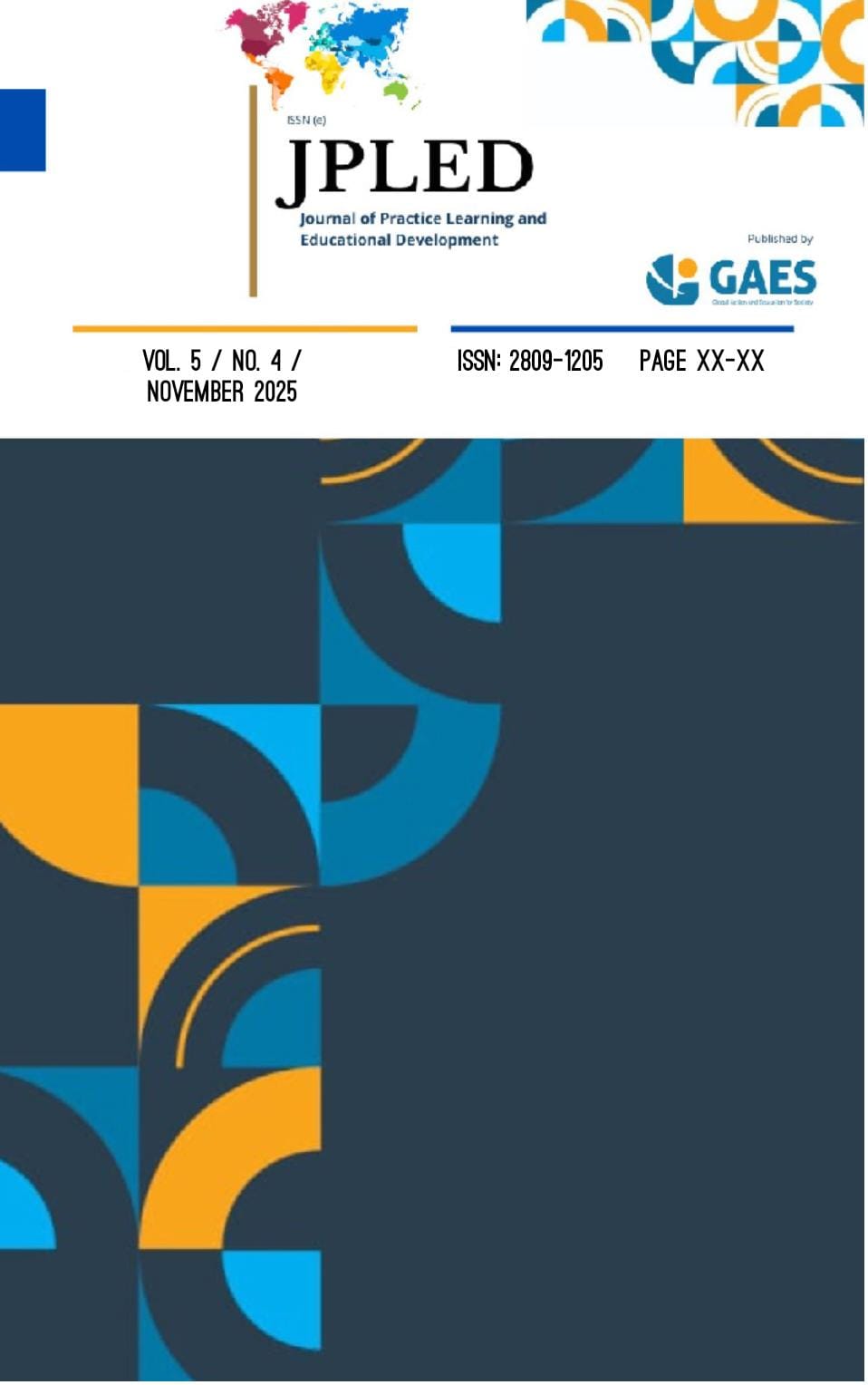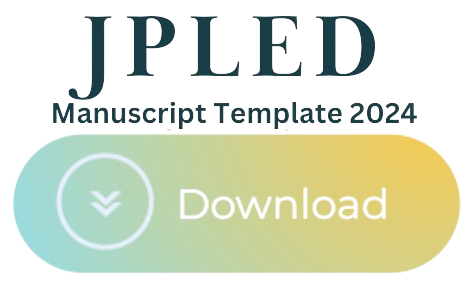Improving the Ability to Analyze Intrinsic Elements of Short Stories Through the Application of the Inside Outside Circel (IOC) Learning Model With Student Centered Approach
DOI:
https://doi.org/10.58737/jpled.v5i4.666Keywords:
Inside Outside Circle (IOC) Learning Model With Student Centered Approach, Intrinsic Elements of Short StoriesAbstract
This study aims to: (1) Determine the ability of fourth grade students of SDN 24 Sembawa to analyze the intrinsic elements of short stories through the application of the Inside Outside Circle (IOC) learning model with a student centered approach; (2) Determine the percentage increase in the ability to analyze the intrinsic elements of short stories of fourth grade students of SDN 24 Sembawa through the application of the Inside Outside Circle (IOC) learning model with a student centered approach. This type of research is an action research carried out in 2 cycles and each cycle consists of two meetings. This research was conducted in fourth grade students of SDN 24 Sembawa, Banyuasin Regency. Data collection techniques were carried out through test activities. The results of this study indicate that: (1) Through the application of the inside outside circle (IOC) learning model with a student centered approach, the ability of fourth grade students of SDN 24 Sembawa to analyze the intrinsic elements of short stories can be improved; (2) The percentage increase in the ability of fourth grade students of SDN 24 Sembawa to identify the intrinsic elements of short stories from cycle I to cycle II is 5.92%.
Downloads
References
Ahmad, K., & Amirullah, S. (2019). Journal of Research on Technology and Educational Innovation Improving the ability to analyze intrinsic elements of short stories through inquiry learning in grade IX junior high school students . 2 (1), 126–138.
Adriani. (2016). Increased ability to analyze intrinsic elements of short stories with models. Pepatuzdu Journal , 11 (1), 19–32.
Aziz, M. T. (2023). Pengembangan Kurikulum Pembelajaran Bahasa Arab: Konsep dan Analisis. GAES-PACE Book Publisher.
Andriani, R. (2016). Implementation of Inside Out Side Circle Learning Model to Improve Students' Ability to Analyze Intrinsic and Extrinsic Elements of Short Stories. Indonesian Language Education Journal. Volume 3 Issue 1 Pages 231-244.
AT, Hamka, H., & Syamsuria, S. (2025). The effect of teacher teaching variations on student learning motivation. Journal of Education and Teaching Review , 8 (2), 3701–3710. https://doi.org/10.31004/jrpp.v8i2.44166
Attarad, Budiyanto. (2016). Efforts to Improve Learning Outcomes Through the Application of the SCA Sociology Learning Model for Grade 11 Students of SMA Negeri 1 Palopo . Journal of Education and Learning. Issue 2 (1). Pages 90-113.
Arik u nto, Suharsimi. (2019). Action Research Procedures . Jakarta: Bumi Aksara.
Azmi, Nurul. (2015). Implementation of the Application of the Inside Outside Circle Learning Model in Improving the Ability to Identify Natural Resources in Geography Subjects of Grade XI Students of SMA Negeri 1 Sampali . Journal of Social Science Education. Issue 3 (1). Volume 133-142.
Burhan, Abbas. (2016). Introduction to Literary Theory . Jakarta: Rineka Cipta .
Ministry of National Education. (2017). Teaching Indonesian Language in Elementary Schools . Jakarta: Ministry of National Education .
Effendi, Ahmad. (2017). Study of Short Story Literary Fiction . Jakarta: Remaja Rosdakarya.
Hamalik, Oemar. (2014). Teaching and Learning Process . Jakarta : PT. Bumi Aksara.
Hasanuddin. (2016). Understanding Literature. Bogor : Galia Indonesia.
Heri, E. (2019). Initiating a Short Story. Semarang: Alprin.
Hopkins, D. (2016). Teacher's Guide: Classroom Action Research . Yogyakarta : Pustaka Belajar
Jacobsen, Jacob. (2019). Teaching and Cooperative Learning Models . Semarang: UNISSULA Press.
Kosasih. E. (2016). Understanding Literature . Yogyakarta: Student Library.
Kurniawati. Khumairo. (2019). Implementation of Cooperative Learning Model. Bandung: Pustaka Setia.
Lie, Anita. (2008). Cooperative Learning : Practicing Cooperative Learning in Classrooms. Jakarta: Grasindo
Masitoh. Kurniawan, Limbang. (2017). Characteristics of Cooperative Learning Models . Yogyakarta : Pustaka Ifadah.
Muslimah, Syifa. (2014). Innovative Learning Model . Yogyakarta: Ar- Ruzz Media.
Nugraheni, Puspita. (2018). Student Centered Approach Learning Model . Bogor: Ghalia Indonesia.
Palukandang, Herman. (2018). The Effectiveness of Cooperative Learning Model on Creative Thinking Skills in Social Studies Subjects . Scientific Journal of Education and Learning, 2(2). Volume 2. Pages 173-188.
Pasehulisan, Wardarita, Ratu, Missriani. (2021). Improving Understanding of Intrinsic Elements and Religious Values in Short Stories Through Learning the Wattshap Group Application . Volume 5. Issue 3. pages 6009-6019. Accessed on October 19, 2024. At 10.00 WIB.
Poe, Francis. (2016). Introduction to Literary Science and Fiction Studies . Jakarta: Pustaka Jaya.
Rahayu, E., Muhtarom, I., & Mujtaba, S. (2021). The Value of Tolerance in Short Stories Published by Republika Online Newspaper and Its Relevance as Literature Teaching Material in High School. Basastra: Journal of Language, Literature, and Its Teaching , 9 (1), 24. https://doi.org/10.20961/basastra.v9i1.48068
Rahmawati. Kurniawati. (2015). SCA Cooperative Learning Model. Yogyakarta: Student Library.
Riswandi. (2013). Theory of Literary Studies . Bogor: Galia Indonesia .
Romhalinda, Indah. Wardiah, Dessy. Ali, Muhammad. (2023). Improving the Ability to Listen to Fiction Stories Through Audio Visual Media on the Learning Outcomes of Class III Students of SD Negeri 213 Palembang . Journal of Education, Volume 5 Issue 3 Pages 104232-10433.
Roestiyah. ( 2017 ) . Teaching and Learning Strategies . Jakarta: PT Remaja Rosdakarya.
Rousseau, William. (2015) . Cooperative Learning . Jakarta: Gaung Persada .
Rachmawati. (2015). Development of Learning Media in Teaching . Bandung: Wacana Prima.
Rousseau, Wiliam .(2015). Active and Innovative Teaching and Learning Strategies . Bandung: Algesindo.
Rustia. (2017). Teaching and Learning Strategies . Jakarta: Rineka Cipta.
Shoimin, Aris. (2014). Innovative Learning Models in the 2013 Curriculum . Yogyakarta; AR- Media .
Sinambela, Richard. ( 2017). Contextual Learning Model . Jakarta: Alfa Beta
Seprie, S. (2024). Comparative study of the use of digital and conventional learning media in elementary school students. Syntax Literate: Indonesian Scientific Journal, 9 (7). DOI: https://doi.org/10.36418/syntax-literate.v9i7.15900
Sudrajat. (2015). Student-centered Cooperative Learning Model . Jakarta: Reneka Cipta.
Sudjana, Nana. (2012). Educational Research . Jakarta: Alfabeta.
Suherli. (2017). Efforts to Improve the Ability to Analyze the Language Style of Bulukumba Folk Tales Through the Investigation Group Learning Model of Class X Students of SMA Negeri 1 Bulukumba . Indonesian Language and Literature Journal. Issue 3 (2). Pages 125-13
Suprijono, Agus. ( 2009 ) . Cooperative Learning , Theory and Application of PAIKEM. Surabaya: Pustaka Pelajar.
Sir, Shoimin. (2014). Active and Innovative Learning Models and Methods . Yogyakarta: Pustaka Pelajar.
Sudrajat, A. (2015). Teaching and Learning Strategies . Yogyakarta: Paramitra Publishing.
Suprijono. (2010). Learning Strategies and Models . Jakarta: Pranada Medisa Group.
Tarigan, Guntur, Hendry.(2014) . Theory of Fiction Studies . Jakarta: Rineka Cipta .
Taufik, Muhammad. Ruganda. (2014). Analysis of Humanist Values in Short Stories in Horizon Magazine with a Psychological Approach as Learning Material for Literary Appreciation in High School. Metasastra Journal. Volume 6 (1). Pages 436-451.
Trianto. ( 2015 ) . Designing Innovative, Progressive and Contextual Learning Models. Surabaya : Prenada Media .
Published
How to Cite
Issue
Section
License
Copyright (c) 2025 Femmy Murniati, Dessy Wardiah, Muhammad Ali

This work is licensed under a Creative Commons Attribution-NonCommercial 4.0 International License.
Journal of Practice Learning and Educational Development is licensed under a Creative Commons Attribution 4.0 International License. This permits anyone to copy, redistribute, remix, transmit and adapt the work provided the original work and source is appropriately cited.












